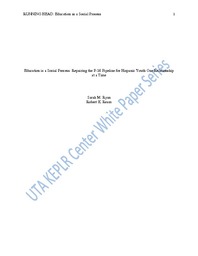
ATTENTION: The works hosted here are being migrated to a new repository that will consolidate resources, improve discoverability, and better show UTA's research impact on the global community. We will update authors as the migration progresses. Please see MavMatrix for more information.
Show simple item record
| dc.contributor.author | Ryan, Sarah M. | |
| dc.contributor.author | Ream, Robert K. | |
| dc.date.accessioned | 2013-08-07T17:14:25Z | |
| dc.date.available | 2013-08-07T17:14:25Z | |
| dc.date.issued | 2013 | |
| dc.identifier.uri | http://hdl.handle.net/10106/11914 | |
| dc.description | Even as Latino college enrollment and graduation rates are at an all time high, the fact that Latino students have continued to lose ground to their non-Latino White and Black peers in four-year college enrollment and bachelor's degree attainment constitutes a critical policy issue (Bowen, Chingos, & McPherson, 2009; Tienda, 2009). Filling in the missing pieces of this Hispanic college puzzle (Alon, Domina, & Tienda, 2010; Tienda, 2011) will be essential to realize the potential "demographic dividend" embedded in the diverse youth population that will enter the U.S. workforce in the next two decades (Tienda & Alon, 2007; Tienda & Mitchell, 2006). As a predominantly White generation of baby boomers continues to settle into retirement, ensuring that the youth who replace them in the labor market and civil society—a significant proportion of whom will be Latino—have the educational credentials to do so must become a national priority. The educational success of Latino students can no longer be considered simply a Latino issue (Latino Policy Forum, 2012). | en_US |
| dc.language.iso | en_US | en_US |
| dc.subject | Education | en_US |
| dc.subject | P-16 Pipeline | en_US |
| dc.subject | Hispanic Youth | en_US |
| dc.title | Education is a Social Process: Repairing the P-16 Pipeline for Hispanic Youth One Relationship at a Time | en_US |
| dc.type | Article | en_US |
| dc.rights.license | Copyrighted by UTA | |
Files in this item
- Name:
- Ryan Ream (2013) Education as ...
- Size:
- 1.363Mb
- Format:
- PDF
- Description:
- PDF
This item appears in the following Collection(s)
Show simple item record


